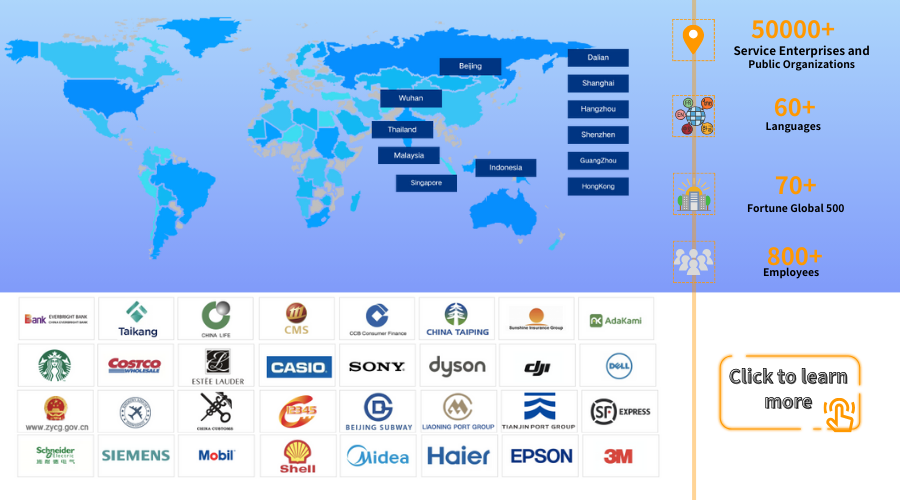Intelligent Omnichannel Customer Service Systems Reshape Travel Experience Amid Surging Passenger Mobility
文章摘要:Against the backdrop of the continuous expansion of population mobility, the average daily number of passengers served by transportation hubs has exceeded 100 million. To meet the diversified service demands across regions and scenarios, omnichannel customer service systems are deeply integrating into scenarios such as airports, railway stations, subways, and bus stations. Through technologies like multi-channel integration, intelligent routing, and data analysis, they are building a smart service system covering the entire travel process of passengers.
Table of contents for this article
- I. Technical Architecture: The Underlying Support for Omnichannel Integration
- II. Scenario-Based Applications: From Single-Point Breakthroughs to Full-Process Coverage
- 1. Airports: A Three-Dimensional Service Network for Smart Hubs
- 2. Railway Stations: Precision Upgrade of Passenger Services
- 3. Subways: Digital Reconstruction of Urban Arteries
- 4. Bus Stations: Intelligent Transformation of Customized Travel
- III. Data-Driven: From Service Response to Decision Optimization
- IV. Future Vision: An Intelligent Service Ecosystem of Human-Machine Collaboration
- V. Service Model Innovation: From Passive Response to Active Care
- 1. Emotional Perception and Dynamic Service Adjustment
- 2. Full-Cycle Care for Special Groups
- 3. Commercial Ecosystem Integration Services
- VI. Regional Collaboration: Building a National Transportation Service Network
- 1. Cross-Hub Information Sharing and Collaborative Services
- 2. Linked Disposal of Emergency Events
- 3. Extension of Transportation Services for Rural Revitalization
- VII. Technological Evolution: Opening a New Era of Intelligent Services
- 1. Construction of Metaverse Customer Service Space
- 2. Quantum Communication Ensures Data Security
- 3. Brain-Computer Interface Improves Interaction Efficiency
- VIII. Sustainable Development: Intelligent Services and Green Travel Go Hand in Hand
- 1. Energy Management Optimization
- 2. Guidance for Resource Recycling
- 3. Carbon Footprint Tracking and Emission Reduction Incentives
I. Technical Architecture: The Underlying Support for Omnichannel Integration
II. Scenario-Based Applications: From Single-Point Breakthroughs to Full-Process Coverage
1. Airports: A Three-Dimensional Service Network for Smart Hubs
2. Railway Stations: Precision Upgrade of Passenger Services
3. Subways: Digital Reconstruction of Urban Arteries
4. Bus Stations: Intelligent Transformation of Customized Travel
III. Data-Driven: From Service Response to Decision Optimization

IV. Future Vision: An Intelligent Service Ecosystem of Human-Machine Collaboration
V. Service Model Innovation: From Passive Response to Active Care
1. Emotional Perception and Dynamic Service Adjustment
2. Full-Cycle Care for Special Groups
3. Commercial Ecosystem Integration Services
VI. Regional Collaboration: Building a National Transportation Service Network
1. Cross-Hub Information Sharing and Collaborative Services
2. Linked Disposal of Emergency Events
3. Extension of Transportation Services for Rural Revitalization
VII. Technological Evolution: Opening a New Era of Intelligent Services
1. Construction of Metaverse Customer Service Space
2. Quantum Communication Ensures Data Security
3. Brain-Computer Interface Improves Interaction Efficiency
VIII. Sustainable Development: Intelligent Services and Green Travel Go Hand in Hand
1. Energy Management Optimization
2. Guidance for Resource Recycling
3. Carbon Footprint Tracking and Emission Reduction Incentives
1. Airports: A Three-Dimensional Service Network for Smart Hubs
2. Railway Stations: Precision Upgrade of Passenger Services
3. Subways: Digital Reconstruction of Urban Arteries
4. Bus Stations: Intelligent Transformation of Customized Travel
III. Data-Driven: From Service Response to Decision Optimization

IV. Future Vision: An Intelligent Service Ecosystem of Human-Machine Collaboration
V. Service Model Innovation: From Passive Response to Active Care
1. Emotional Perception and Dynamic Service Adjustment
2. Full-Cycle Care for Special Groups
3. Commercial Ecosystem Integration Services
VI. Regional Collaboration: Building a National Transportation Service Network
1. Cross-Hub Information Sharing and Collaborative Services
2. Linked Disposal of Emergency Events
3. Extension of Transportation Services for Rural Revitalization
VII. Technological Evolution: Opening a New Era of Intelligent Services
1. Construction of Metaverse Customer Service Space
2. Quantum Communication Ensures Data Security
3. Brain-Computer Interface Improves Interaction Efficiency
VIII. Sustainable Development: Intelligent Services and Green Travel Go Hand in Hand
1. Energy Management Optimization
2. Guidance for Resource Recycling
3. Carbon Footprint Tracking and Emission Reduction Incentives
3. Subways: Digital Reconstruction of Urban Arteries
4. Bus Stations: Intelligent Transformation of Customized Travel
III. Data-Driven: From Service Response to Decision Optimization

IV. Future Vision: An Intelligent Service Ecosystem of Human-Machine Collaboration
V. Service Model Innovation: From Passive Response to Active Care
1. Emotional Perception and Dynamic Service Adjustment
2. Full-Cycle Care for Special Groups
3. Commercial Ecosystem Integration Services
VI. Regional Collaboration: Building a National Transportation Service Network
1. Cross-Hub Information Sharing and Collaborative Services
2. Linked Disposal of Emergency Events
3. Extension of Transportation Services for Rural Revitalization
VII. Technological Evolution: Opening a New Era of Intelligent Services
1. Construction of Metaverse Customer Service Space
2. Quantum Communication Ensures Data Security
3. Brain-Computer Interface Improves Interaction Efficiency
VIII. Sustainable Development: Intelligent Services and Green Travel Go Hand in Hand
1. Energy Management Optimization
2. Guidance for Resource Recycling
3. Carbon Footprint Tracking and Emission Reduction Incentives
III. Data-Driven: From Service Response to Decision Optimization

IV. Future Vision: An Intelligent Service Ecosystem of Human-Machine Collaboration
V. Service Model Innovation: From Passive Response to Active Care
1. Emotional Perception and Dynamic Service Adjustment
2. Full-Cycle Care for Special Groups
3. Commercial Ecosystem Integration Services
VI. Regional Collaboration: Building a National Transportation Service Network
1. Cross-Hub Information Sharing and Collaborative Services
2. Linked Disposal of Emergency Events
3. Extension of Transportation Services for Rural Revitalization
VII. Technological Evolution: Opening a New Era of Intelligent Services
1. Construction of Metaverse Customer Service Space
2. Quantum Communication Ensures Data Security
3. Brain-Computer Interface Improves Interaction Efficiency
VIII. Sustainable Development: Intelligent Services and Green Travel Go Hand in Hand
1. Energy Management Optimization
2. Guidance for Resource Recycling
3. Carbon Footprint Tracking and Emission Reduction Incentives

V. Service Model Innovation: From Passive Response to Active Care
1. Emotional Perception and Dynamic Service Adjustment
2. Full-Cycle Care for Special Groups
3. Commercial Ecosystem Integration Services
VI. Regional Collaboration: Building a National Transportation Service Network
1. Cross-Hub Information Sharing and Collaborative Services
2. Linked Disposal of Emergency Events
3. Extension of Transportation Services for Rural Revitalization
VII. Technological Evolution: Opening a New Era of Intelligent Services
1. Construction of Metaverse Customer Service Space
2. Quantum Communication Ensures Data Security
3. Brain-Computer Interface Improves Interaction Efficiency
VIII. Sustainable Development: Intelligent Services and Green Travel Go Hand in Hand
1. Energy Management Optimization
2. Guidance for Resource Recycling
3. Carbon Footprint Tracking and Emission Reduction Incentives
2. Full-Cycle Care for Special Groups
3. Commercial Ecosystem Integration Services
VI. Regional Collaboration: Building a National Transportation Service Network
1. Cross-Hub Information Sharing and Collaborative Services
2. Linked Disposal of Emergency Events
3. Extension of Transportation Services for Rural Revitalization
VII. Technological Evolution: Opening a New Era of Intelligent Services
1. Construction of Metaverse Customer Service Space
2. Quantum Communication Ensures Data Security
3. Brain-Computer Interface Improves Interaction Efficiency
VIII. Sustainable Development: Intelligent Services and Green Travel Go Hand in Hand
1. Energy Management Optimization
2. Guidance for Resource Recycling
3. Carbon Footprint Tracking and Emission Reduction Incentives
VI. Regional Collaboration: Building a National Transportation Service Network
1. Cross-Hub Information Sharing and Collaborative Services
2. Linked Disposal of Emergency Events
3. Extension of Transportation Services for Rural Revitalization
VII. Technological Evolution: Opening a New Era of Intelligent Services
1. Construction of Metaverse Customer Service Space
2. Quantum Communication Ensures Data Security
3. Brain-Computer Interface Improves Interaction Efficiency
VIII. Sustainable Development: Intelligent Services and Green Travel Go Hand in Hand
1. Energy Management Optimization
2. Guidance for Resource Recycling
3. Carbon Footprint Tracking and Emission Reduction Incentives
2. Linked Disposal of Emergency Events
3. Extension of Transportation Services for Rural Revitalization
VII. Technological Evolution: Opening a New Era of Intelligent Services
1. Construction of Metaverse Customer Service Space
2. Quantum Communication Ensures Data Security
3. Brain-Computer Interface Improves Interaction Efficiency
VIII. Sustainable Development: Intelligent Services and Green Travel Go Hand in Hand
1. Energy Management Optimization
2. Guidance for Resource Recycling
3. Carbon Footprint Tracking and Emission Reduction Incentives
VII. Technological Evolution: Opening a New Era of Intelligent Services
1. Construction of Metaverse Customer Service Space
2. Quantum Communication Ensures Data Security
3. Brain-Computer Interface Improves Interaction Efficiency
VIII. Sustainable Development: Intelligent Services and Green Travel Go Hand in Hand
1. Energy Management Optimization
2. Guidance for Resource Recycling
3. Carbon Footprint Tracking and Emission Reduction Incentives
2. Quantum Communication Ensures Data Security
3. Brain-Computer Interface Improves Interaction Efficiency
VIII. Sustainable Development: Intelligent Services and Green Travel Go Hand in Hand
1. Energy Management Optimization
2. Guidance for Resource Recycling
3. Carbon Footprint Tracking and Emission Reduction Incentives
VIII. Sustainable Development: Intelligent Services and Green Travel Go Hand in Hand
1. Energy Management Optimization
2. Guidance for Resource Recycling
3. Carbon Footprint Tracking and Emission Reduction Incentives
2. Guidance for Resource Recycling
3. Carbon Footprint Tracking and Emission Reduction Incentives
The article is original by Udesk, and when reprinted, the source must be indicated:https://my.udeskglobal.com/blog/intelligent-omnichannel-customer-service-systems-reshape-travel-experience-amid-surging-passenger-mobility.html
Customer Service PlatformIntelligent Customer ServiceOmnichannel Customer Service System

 Customer Service& Support Blog
Customer Service& Support Blog


